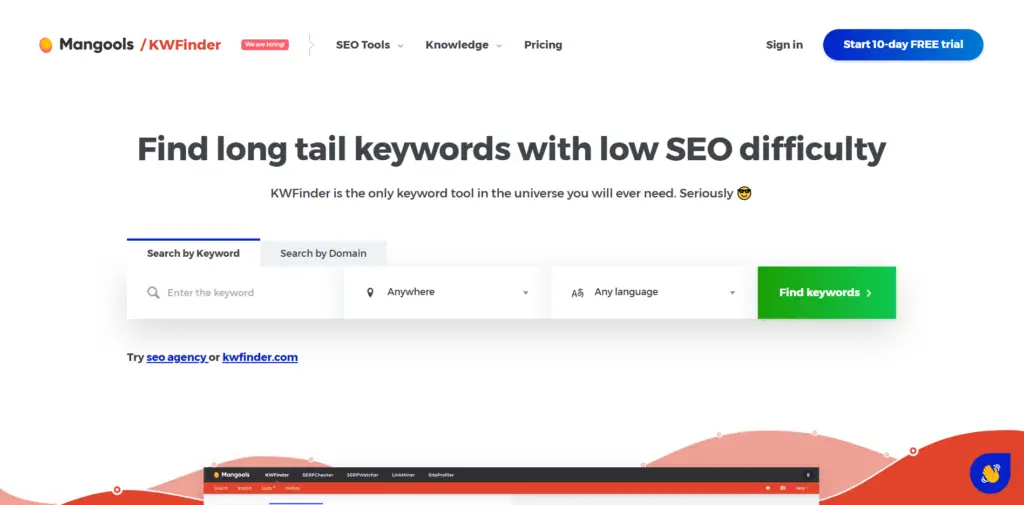Disclosure: Sportshubnet is supported by its audience. When you purchase through links on our site, we may earn an affiliate commission. Learn More.
In this post, we will check out how to find long tail keywords and the top 10 tools for finding long tail keywords in 2023.
In the world of search engine optimization (SEO), keywords play a vital role in driving traffic to your website. However, with the increasing competition online, it’s becoming more challenging to rank for highly competitive keywords. That’s where long-tail keywords come in.
Long-tail keywords are longer, more specific phrases that people use when searching for something online. They are highly targeted and have a lower search volume than broad keywords.
However, they are also less competitive and can be easier to rank for. By targeting long-tail keywords, you can attract highly qualified traffic to your website and increase your chances of conversion.
So, how do you find long-tail keywords? In this article, we’ll explore some of the best ways to identify long-tail keywords for your website and optimize your content for better search engine visibility.
How To Find Long Tail Keywords
1 Install the ‘Keywords Everywhere’ Extension

Installing the ‘Keywords Everywhere’ extension is an easy way to get started. It’s available for both Firefox and Chrome, and you can find it by searching for ‘keywords everywhere on Google.
Once you installed the extension on your browser, try searching for keywords on Google and keywords everywhere will provide you the data which includes trends, search volume, and CPC.
This data will helps you to target valuable keywords when it comes to content generation.
2 Look at the ‘People also asks’ carousel

The ‘People also ask’ carousel is a great place to find long tail keywords.
It can be found in the middle of any Google search page, usually below the top 2 search results. The carousel shows you related questions people have about your topic.
For example, if you’re looking for keywords for an article about how to grow tomatoes (that might be a strange topic), you can use this feature to discover more ways that people search for information on growing tomatoes and whether they’re using those words as part of their queries or not.
3 Check out autocomplete suggestions

Google Suggestions are goldmines when it comes to finding out long tail keywords. Just start typing your primary keyword into Google and Google will recommend you with a ton of long-tail keywords in Google suggests.
So if you find a long tail keyword in google suggest going with that keyword and creating content on it and it will help you to bring ton of traffic and visitor to your site.
However, it’s not the most suitable method for analyzing long-tail keywords, and that’s when the keywords tool comes into play.
4 Research your competitors
Researching on your competitors is another great way of finding top long-tail keywords for your campaign. You can do that with the help of Google search and SEO tools.
You can glance at your competitors to understand which specific long-tail keywords they’re using which make them at the top of the search results.
Just note those keywords and try to create great content on them and replace your competitors at the top of the search results.
5 Use Google’s Related Searches

You may have found when you search for a seed keyword on Google, related keywords are easily examined at the bottom of the page.
This is another great way to find long tail keywords. You may get a little more suggestions here and they may also be more personalized.
So go with these related keywords and start creating content on these keywords for exposure and traffic to your blog.
Best Tools for Finding Long-Tail Keywords
1 Semrush

SEMRush is an SEO, marketing, and analytics research suite. When it comes to SEO, it enables you to look up what keywords your competitors are using, deduce their rankings, and find new search terms, among many other features.
When it comes to marketing, SEMRush allows you to take your organic traffic, and compare it with your paid traffic. It will help you find more keywords your audience might be using, and give you ideas on how to attract more organic traffic.
Google Keyword Planner is Google’s own keyword research tool. While it’s not as in-depth as SEMRush, it still comes in handy.
There are many other cool features as well, including tracking your rankings on Google search and analyzing your competitors’ backlinks.
This is my favorite SEO tool, the one I use most often in my business. You can use Semrush for free with limitations or switch to a starter plan which starts at $119.95/month.
2 KW Finder

KWFinder is a fully-free long tail keyword research tool. Similar to the other keyword tools, this one also highlights the keyword suggestions, their trends, and the number of searches, CPC, & difficulty level.
An important feature of this tool is that it provides keyword suggestions that are not only singular but also long-tail keywords.
The data generated by the tool is excellent and can be used as a primary metric or used as a secondary metric to help you figure out the right keywords to target.
KWFinder is a relatively new tool in the market of long-tail keyword tools. However, it has exceptional features and functionalities that give it an edge over all the other new keyword research tools.
You can also automatically import a list of keywords from a spreadsheet. KWFinder is easy to use and has a ton of value for those who are serious about keyword research.
3 Ahrefs

Ahrefs is another fantastic tool you can use to rank well in search engines. With Ahrefs, you get access to tools that help to research your competitors, monitor your niche, and grow your search traffic.
You can also find data about your competitors’ backlinks, link popularity, and domain authority. There’s an Ahrefs app for Chrome, Safari, and Firefox that gives you insight into how your competitors are ranking on Google and other search engines, which gives you a leg up on where to spend your time optimizing.
You can easily find out which keywords are generating the most traffic, which keywords people are using to find your content, and your competitors’ backlink profiles to see where they’re getting their links.
4 Answer The Public

Answer the Public is a free tool that allows you to peek up search engine recommendations for any keywords you enter.
For each keyword you glance for, it’ll show you what questions people are asking about it. For example, if you search for “Catholicism”, Answer the Public will show you what people are asking about the religion, but also what people are asking about its teachings on marriage, abortion, birth control, and other topics.
The tool is useful for those who want to better understand the public’s opinions on certain topics, but also for those who are interested in the search engine’s potential biases.
For example, if you search for “Vatican”, you’ll see the top search results for the Catholic Church, but you’ll also see results concerning the Pope and the Catholic Church’s teachings on sexual abuse. The tool lets you click on the ones you want to read.
The tool integrates with nearly all search engines to provide content and suggestions based on your search terms.
5 Moz

Moz provides you with an excellent interface to make keyword discovery easy. It will show you both numeric and pictorial representations of a keyword’s monthly search volume, and lets you dig down to keyword-specific data and see more metrics.
You can also highlight or reorder search terms on the Moz homepage for easier ordering. With the insights Moz can share, you’ll have a better understanding of how your keywords are performing, and you can use that knowledge to make better, more informed decisions.
The keyword’s opportunity for ranking, priority, and difficulty. This will help you determine which keywords are worth investing in and which can be delayed until later.
It’ll also show you the big picture — how you as a company, as a brand, and as an individual are doing as a whole. This will help you know where to focus your efforts and which keywords to prioritize. Moz is number 5 in our list of 10 tools for finding long tail keywords in 2023.
6 WordTracker

WordTracker is a great tool for in-depth keyword research and can help you generate a large number of competitive long-tail keywords.
However, if you are new to SEO and want a simpler option, then perhaps starting with the free version of WordTracker is a better idea.
WordTracker offers a 7-day free trial to test out the tool and have access to long tail keywords. This is a good option if you want to understand the basics of SEO and build a small list of long-tail keywords.
The tool provides a wide range of data such as the amount of organic search volume, the number of monthly searches, and the average cost-per-click.
You can also check the top 10 keywords by volume and their competition levels with WordTracker. Wordtracker is number 6 in our list of 10 tools for finding long tail keywords 2023.
7 Ubersuggest

Ubersuggest is a prevalent free Keyword research tool. It helps you in searching for the best keywords for your website.
Ubersuggest displays the basic information of the keywords like the average CPC, competition, and other relevant information.
You can also use Ubersuggest to find the best long-tail keywords for your website. The tool generates detailed suggestions based on the keywords you type and the search engines that you are targeting.
Keyword targeting helps you get more traffic and also higher search ranks. Ubersuggest is surely one of the best free tools out there in the market. Ubersuggest is number 7 on our list of top 10 tools for finding long tail keywords in 2023.
8 Keywords Everywhere

Keywords Everywhere are very distinct from the long-tail keyword generator tools we’ve showcased so far. It’s a browser extension that’s available for Chrome and Safari.
It also generates longer, unique, and alternative search terms, and it aims to make it easier for users to find the keywords they’re after without having to rack their brains looking for the right term.
It works silently by tracking the keywords you type into the browser and providing relevant results as you type.
It’s a convenient tool, but it’s also a powerful one. Every keyword generator we’ve ever shown you can help you find new customers and boost your search rankings.
But Keywords Everywhere can do so much more. It can generate long-tail keywords that are unique and relevant to your business.
It can help you generate keyword ideas, build web traffic, and level up your search engine ranking. But those are just the start. You can use Keywords Everywhere for so much more.
9 KeywordTool.io

Another free tool, KeywordTool.io is ideal for forging ideas for long-tail keywords. It’s free to use and gives you a ton of information about what keywords you should be targeting.
You enter your keywords and optionally your desired number of words, and receive back keywords and description ideas. This is a super-useful tool.
I’ve used this site for years to find new ways to stimulate my interest and target audiences. I’ve been using it for years because it’s one of the only places I’ve found that provides both inspiration and profitable ideas.
10 Google Trends

Google Trends is not exactly a long-tail keyword generator. However, if you learn how to utilize the tool, you’ll discover it’s a strong way to find keyword suggestions based on what people are peeking for with Google.
It’s also a quick way to get a feel for what your potential audience is interested in. For example, let’s say you’re a writer who wants to rank for the keyword “content creation blog” on Google.
You could use the tool to find out what people have been searching for in the past five years. On the surface, that data might not seem like much, but if you dig deeper, you’ll see the phrase “content creation blog” was a popular search over the last five years.
The key benefit of Google Trends is its ability to dive into a specific topic to drill deeper, which is what makes it so powerful for content research. Google Trends is number 10 in our list of 10 tools for finding long tail keywords in 2023.
Conclusion
There are many places to get long tail keywords. You can find them on your own, through research and brainstorming, or you can hire someone to do it for you.
You might be surprised at how little competition there is for certain long-tail keywords if you’re not very specific with your keyword research.
As mentioned earlier in this article, the more specific the keyword is, the more likely it is to be searched for by people who have that particular need.
That means less competition for you! When choosing which long tail keywords to target first, we recommend going after those with relatively low search volume but high levels of monthly searches and low competition (by checking out our free tool).
This will help ensure that readers will find what they’re looking for when visiting your site thanks to a higher relevance score from Google—and therefore increase traffic and leads over time as well!
As you can see, many ways to find long tail keywords exist. You can use Google itself or other sites like KW Finder and SEMRush.
Inbox looking a bit bland?
Better sign up to our blog to cram it full of trending Sports, Gaming & Tech updates.




